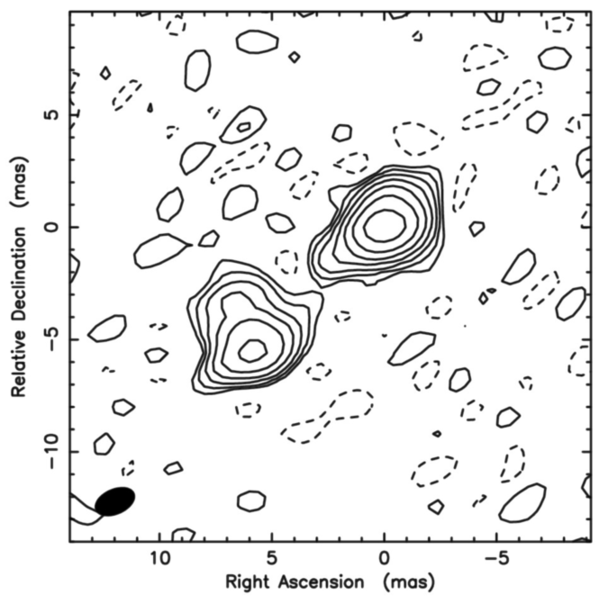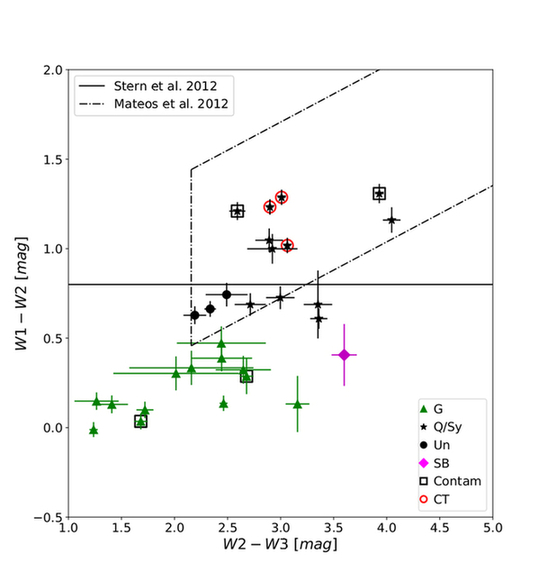Astronomy Object of the Month: 2021, April
< previous Archive next >
A Multi-wavelength look at a sample of Compact Radio Galaxies
Compact radio galaxies are a particularly interesting class of active galactic nuclei (AGN), with newly born
radio structures (jets and lobes) fully confined within their host galaxies. They can provide information on
the processes that lead to the production of relativistic jets in AGN, as well as insight into the complex
dynamics of feedback between evolving supermassive black holes and interstellar medium. Recently work was
published by an international group, led by researchers at the Astronomical Observatory of Jagiellonian
University, on the infrared X-ray properties of a sample of 29 of this type of galaxy.

Illustration 1: 22 GHz VLBI radio imaging of CSO object
PKS 1718-649. Credit: Tingay, de Kool (2003).
Radio galaxies are fascinating objects that have for many years perplexed astronomers. They emit an unusually
large amount of energy at radio frequencies and have large jets of matter travelling near the speed of light
launched from their centers. It was once thought that radio galaxy jets did not follow the fundamental law of
physics which states that nothing can travel faster than the speed of light. It is now known that the jets only
appear to be moving faster than the speed of light, because of their orientation. However, a complete understanding
of how these jets are formed and sustained remains elusive.
Researchers focused on an investigation of the mid-infrared (MIR) properties of a sample of the most compact radio galaxies, containing radio lobes less than 1 kpc, based on low-resolution data provided by the WISE and IRAS satellites, in order to shed some light on this problem. These sources are confirmed spectroscopically in the radio domain as 'GHz-peaked spectrum' (GPS) sources, and/or morphologically (using high-resolution radio interferometers) as 'compact symmetric objects' (CSOs). The inspection of optical images for the targets, implies that the analyzed GPS/CSOs are hosted predominantly by red and yellow galaxies with an elliptical shape, with several cases containing distorted morphology or signs of galaxy interaction.
Through the inspection of the mid-infrared luminosities, a variety of WISE colors was found, suggesting that the MIR continua of the studied sources are contributed not exclusively by the circumnuclear dust, but also by the ISM of host galaxies, and in a few cases even by the non-thermal emission of compact jets and lobes, which is shown in Illustration 2. It was found that young radio galaxies with the MIR emission dominated by the ISM component, populate almost uniformly the entire region occupied by galaxies (from elliptical to starbursts) with a wide range of a pronounced star formation activity. Through the study of two-dimensional Kolmogorov-Smirnov tests comparing this sample to other more evolved radio galaxy samples a few conclusions were made:
(1) triggering radio jets in AGN does not differentiate between elliptical hosts with substantially different fractions of young stars,
(2) it is the jet duty cycle -- and not the jet launching itself -- which is related to the star formation rate within the host, in that radio galaxies hosted by galaxies with more pronounced population of young stars are either typically short lived (i.e., not surviving long enough to form an extended FR-II structure), or characterized by a highly modulated/recurrent jet activity.

Illustration 2: Young radio galaxies with the MIR emission dominated by
the ISM component populate almost uniformly the entire region occupied by galaxies (from elliptical to starbursts) with a
wide range of a pronounced star formation activity.
Credit: The Authors.
Additionally, the team inspected the gamma-ray (Fermi-LAT) detections of two of the sources from the sample, 1146+596 and 1718-649. These are the two nearest sources in the sample, and the only CSO’s to be detected in Gamma-rays. The team concludes that the level of gamma-ray emission detected is due to jet activity and cannot be solely due to the star formation activity. This was determined by calculating the star formation rate from the integrated infrared luminosity and using the relationship between infrared/star formation rate and the expected gamma output of said star formation level. In both sources an excess of gamma-ray luminosity shows the influence of jets on the detection.
Original publication: Kosmaczewski E., Stawarz L., Siemiginowska A., Cheung C.C., Ostorero L., Sobolewska M., Kozieł-Wierzbowska D., Wójtowicz A. and Marchenko V., Mid-infrared Diagnostics of the Circumnuclear Environments of the Youngest Radio Galaxies, 2020, ApJ, 897.
The research was conducted at the Department of High Energy Astrophysics of the Jagiellonian University’s Astronomical Observatory (OA UJ). This work was supported by the Polish National Science Centre through the grant NCN 2016/22/E/ST9/00061.
|
Emily Kosmaczewski Astronomical Observatory Jagiellonian University E.Kosmaczewski [at] oa.uj.edu.pl |


